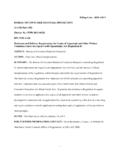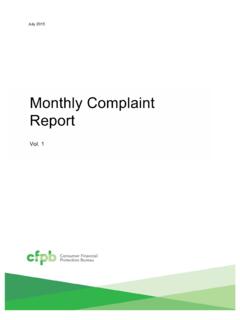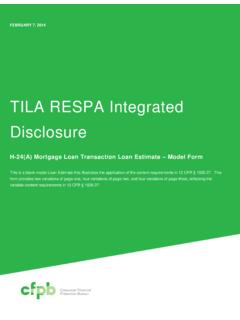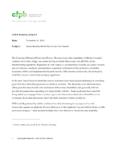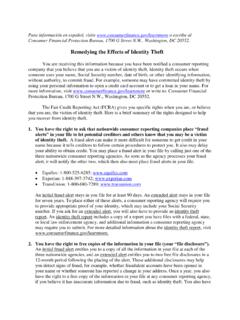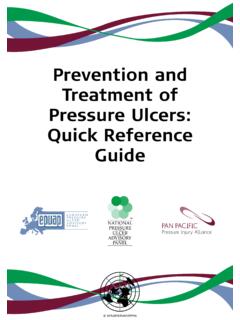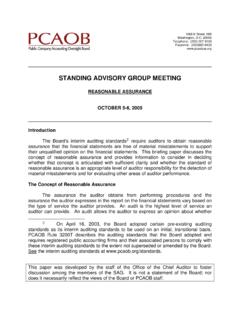Transcription of SMALL BUSINESS ADVISORY REVIEW PANEL FOR …
1 SMALL BUSINESS ADVISORY REVIEW PANEL FOR. AUTOMATED VALUATION MODEL (AVM) RULEMAKING. OUTLINE OF PROPOSALS AND ALTERNATIVES. UNDER CONSIDERATION. February 23, 2022. Contents I. Introduction .. 2. II. The SBREFA 3. III. Proposals and Alternatives Under Consideration .. 5. AVMs used to determine the collateral worth .. 6. 1. AVMs used for making underwriting 6. 2. Reviews of already completed 7. 3. Developing an appraisal by a certified or licensed appraiser .. 8. 4. Post-origination .. 9. i. Loan modifications and other changes to existing loans .. 9. ii. Credit line reductions or 10. iii. 11. 5. Certain AVM use related to appraisal waiver loans .. 13. B. Defining mortgage originators .. 14. 1. General definition of mortgage originator .. 14. 2. Defining mortgage originator to cover servicers under limited 15.
2 C. Defining secondary market issuers .. 15. D. Defining mortgage .. 16. E. Defining consumer's principal dwelling .. 17. 1. Coverage of consumers .. 17. 2. Coverage of dwelling .. 18. 3. Limiting coverage to principal dwelling .. 19. i. Principal dwelling .. 19. ii. Treatment of new construction .. 19. F. Scope of eventual rule 20. 1. Quality control standards 20. 2. Specifying a nondiscrimination quality control 23. G. Implementation 26. IV. Potential Impacts on SMALL Entities .. 27. A. Overview .. 27. B. SMALL entities covered by the options under 29. C. CFPB REVIEW of compliance processes and costs .. 31. Appendix A: Section 1125 of 42. 1. I. Introduction In the Dodd-Frank Wall Street Reform and Consumer Protection Act (Dodd-Frank Act),1. Congress directed the Consumer Financial Protection Bureau (CFPB or we), along with the Board of Governors of the Federal Reserve System (Board), the Comptroller of the Currency (OCC), the Federal Deposit Insurance Corporation (FDIC), the National Credit Union Administration (NCUA), and the Federal Housing Finance Agency (FHFA) (collectively, the agencies), to develop regulations for quality control standards for automated valuation models (AVMs), 2 which are any computerized model used by mortgage originators and secondary market issuers to determine the collateral worth of a mortgage secured by a consumer's principal dwelling.
3 3 Specifically, the Dodd-Frank Act added section 1125 to the Financial Institutions Reform, Recovery, and Enforcement Act of 1989 (FIRREA); 4 that section requires that AVMs meet quality control standards designed to: (1) ensure a high level of confidence in the estimates produced by automated valuation models; (2) protect against the manipulation of data; (3) seek to avoid conflicts of interest; (4) require random sample testing and reviews; and (5) account for any other such factor that the agencies determine to be The statute provides that the eventual section 1125 rule will be enforced by the FDIC, Board, NCUA, and OCC (collectively, prudential agencies) with respect to insured banks, savings associations, and credit unions (collectively, financial institutions), as well as federally regulated subsidiaries that financial institutions own and The statute gives the CFPB, as well as the Federal Trade Commission and State attorneys general, enforcement authority with respect to other non-depository participants in the AVMs are being used with increasing frequency.
4 This trend is being driven in part by advances in database and modeling technology and the availability of larger property datasets. Research indicates that advances in AVM technology and data availability have the potential to contribute to lower costs and shorter turnaround times in the performance of property valuations. 8. However, the use of AVMs may introduce risks, including issues with data integrity and accuracy. Moreover, like algorithmic systems generally, there are concerns that AVMs may reflect bias in design and function or through the use of biased data and may introduce potential fair lending risk. 9 We believe it is important to mitigate fair lending risk in AVMs and to encourage institutions to implement robust compliance management systems that prevent, identify, and correct violations of nondiscrimination laws.
5 As described in part , to address potential fair lending risk in models, we are considering proposing, pursuant to section 1125(a)(5), a requirement that covered institutions establish policies, practices, procedures, and control systems to ensure that their AVMs comply with applicable nondiscrimination laws (we refer to this as a fifth factor ). FIRREA section 1125 applies to mortgages secured by a consumer's principal dwelling and focuses on the importance of ensuring AVM credibility and integrity. For consumers, obtaining a mortgage is one of the most important financial decisions they will ever make and it is a crucial component of access to homeownership, which can be a key building block of consumer wealth. Overvaluing a home potentially can lead the consumer to take on an increased amount of debt 2.
6 That raises risk to the consumer's financial well-being. On the other hand, undervaluing a home can result in a consumer being denied access to credit for which the consumer is otherwise qualified or offered credit at less favorable The agencies listed above are working together to develop a proposed rule to implement FIRREA section 1125. However, while agencies generally are required to consider whether the rules they propose will have a significant economic impact on a substantial number of SMALL entities, pursuant to the Regulatory Flexibility Act (RFA), 11 an amendment to the RFA added by the SMALL BUSINESS Regulatory Enforcement Fairness Act of 1996 (SBREFA) imposes additional requirements on the CFPB with respect to SMALL entities. 12 Prior to issuing a proposed rule, the CFPB must comply with additional procedural requirements to assess the impact on SMALL entities that are likely to be directly affected by the proposals under consideration.
7 As explained below, these additional SBREFA requirements include collecting SMALL entities' advice and recommendations on the potential impacts of the proposals under consideration and feedback on regulatory alternatives to minimize these impacts. II. The SBREFA Process SBREFA directs the CFPB to convene a SMALL BUSINESS REVIEW PANEL ( PANEL ) when it is considering proposing a rule that could have a significant economic impact on a substantial number of SMALL entities. The PANEL includes representatives from the CFPB, the Office of Information and Regulatory Affairs in the Office of Management and Budget, and the Chief Counsel for Advocacy of the SMALL BUSINESS Administration (Advocacy). Advocacy is an independent office within the SMALL BUSINESS Administration (SBA). The PANEL is required to collect advice and recommendations from SMALL entities or their representatives (referred to as SMALL entity representatives, or SERs) that are likely to be subject to a regulation that the CFPB is considering proposing (in this case, development of the CFPB's proposal also will involve continuing work on an interagency basis with the Board, OCC, FDIC, NCUA, and FHFA).
8 For this purpose, the RFA defines SMALL entities as SMALL businesses, SMALL organizations, and SMALL governmental jurisdictions. The term SMALL BUSINESS has the same meaning as SMALL BUSINESS concern under section 3 of the SMALL BUSINESS Act (SB Act);. thus, to determine whether a BUSINESS is a SMALL entity the CFPB looks to the SBA's size standards. 13 The term SMALL organization is defined as any not-for-profit enterprise which is independently owned and operated and is not dominant in its field. The term SMALL governmental jurisdiction is defined as the governments of cities, counties, towns, townships, villages, school districts, or special districts, with a population of less than 50, SMALL entities likely to be directly affected by some of the proposals under consideration within the meaning of SBREFA include real estate credit companies, secondary market financing companies, other non-depository credit intermediation companies that originate mortgages, mortgage loan brokers, and other non-depository institutions related to credit intermediation such as mortgage loan servicers.
9 The maximum size standard for any of these non-depository institutions to be considered SMALL is $ million in average annual receipts, though several have lower In addition to non-depository institutions for which the statute gives the 3. CFPB enforcement authority, the CFPB has identified several categories of SMALL depository institutions whose use of AVMs may be directly affected, including commercial banking institutions, savings institutions, credit unions, and other depository institutions related to credit intermediation with assets of $600 million or less. 16. During the PANEL outreach meeting, SERs will provide the PANEL with important advice and recommendations on the potential impacts on SMALL entities of the proposals under consideration. The SERs also may provide feedback on regulatory alternatives to minimize these impacts on SMALL entities.
10 In addition, the RFA directs the CFPB to collect the advice and recommendations of SERs concerning whether the proposals under consideration might increase the cost of credit for SMALL entities and alternatives that accomplish the stated objectives of applicable statutes and which minimize any such Within 60 days of convening, the PANEL is required to complete a report on the input received from the SERs during the PANEL process. The CFPB will consider the SERs' feedback and the PANEL 's report as the CFPB prepares the eventual proposed rule on an interagency basis with the Board, OCC, FDIC, NCUA, and FHFA. Once the proposed rule is published, the CFPB is required to place the PANEL 's final report in the public rulemaking record. The CFPB also welcomes further feedback from the SERs during the public comment period on the proposed rule.


